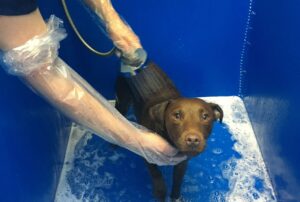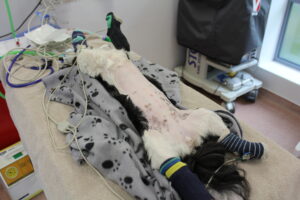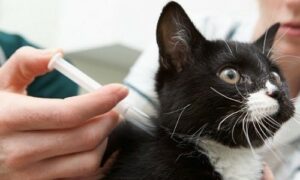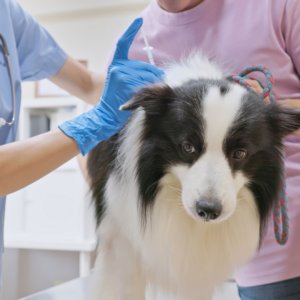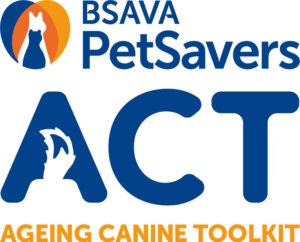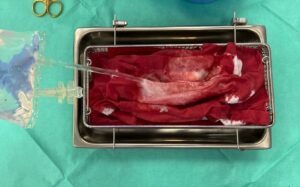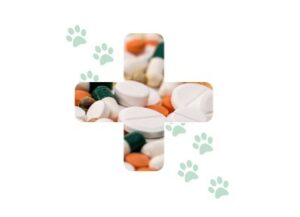Our other current research projects
Explore more PetSavers-funded research in other disease areas
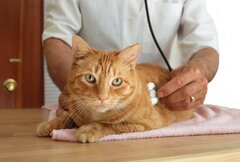 |
FGF-23 and TGF-β1 in cats with acute kidney injury secondary to ureteral obstructionClinical Research Project Grant: £5,574.68 awarded in 2024 Institution: RVC Lead researcher: Jack Lawson This life-threatening condition is treated with subcutaneous ureteral bypass (SUB), but it can impact kidney function. Aim: By investigating biomarkers TGF-β1 and FGF-23, which are linked to the progression from acute to chronic kidney disease in humans, the study aims to improve therapeutic decision-making by identifying cats likely to recover kidney function after SUB placement.
|
|
|
Comparing the perception and attitudes of different groups of people (e.g., veterinarians, animal shelter staff, and feline-owning public) towards feline immunodeficiency virus in cats against published literatureStudent Research Project Grant: £500 awarded in 2024 Institution: University of Edinburgh Lead researcher: Danielle Gunn-Moore Student: Isidore Adams On its discovery, feline immunodeficiency virus (FIV) was represented as a disease of high mortality and morbidity. Aim: This undergraduate project aims to investigate whether the perception of and attitude towards FIV in different groups involved in feline care has changed alongside increased scientific understanding of the disease to determine whether stigmatisation of FIV infection remains in the cat-care community. |
|
|
Pathways to waterways for imidacloprid in Seresto collarsClinical Research Project Grant: £5154 awarded in 2022 Institution: University of Sussex Lead researcher: Rose Perkins There is growing concern among the general public and within the veterinary profession that pesticides used in companion animal flea and/or tick products may be entering the environment at levels sufficient to cause ecological harm. However, little is known about the environmental fate or impact of many of these products, to inform evidence-based decisions regarding their use. Aim: This study aims to investigate pathways to the environment for imidacloprid contained in collars, with a focus on routes to waterways. An article about the study was published in BSAVA’s Companion magazine. |
Our other past research projects
|
|
Investigating the peri- and post-operative outcomes of neutering female dogs by ovariohysterectomy or ovariectomyStudent Research Project Grant: £1200 awarded in 2024 Institution: University of Nottingham Lead researcher: Gary England Student: Elaine Yarwood Neutering by ovariohysterectomy (OVH) is reportedly the most common procedure and the one taught in vet schools; however, laparoscopic techniques and neutering by ovariectomy (OVE) are increasing in frequency. This undergraduate study used retrospective data to examine differences in perioperative and post-operative outcomes when surgical neutering was performed by laparoscopic OVE (n=213) versus OVH by celiotomy (n=306). There was no significant difference in duration or intraoperative complications between the two types of surgery. Postoperative complications, including redness and swelling of the wound site, inappetence, discomfort, uncharacteristic irritability and uncharacteristic licking or chewing of parts of the body were more commonly seen following OVH by celiotomy than after laparoscopic OVE. Take home message: The findings provide evidence to support the contention that postoperative complications, including those related to wound healing and those requiring further veterinary intervention, are lower following laparoscopic than open neutering Elaine presented these findings as an abstract at BSAVA Congress 2025, which can be read here. A recording is freely available (skip to 0:38:38). |
|
|
A mixed methods approach to quantifying and characterising vaccine uptake and vaccine hesitancy in UK companion animalsJoint-funded PhD grant: £50,000 awarded in 2020 Institution: University of Liverpool Lead researcher: Gina Pinchbeck Student: Shona Bloodworth Vaccination is an essential component of preventative healthcare, and the re-emergence of vaccine-preventable diseases has been associated with reduced vaccine uptake. Vaccine hesitancy is a major threat to global health that shows strong variation and is poorly understood. Take home message: Time between vaccinations in cats and dogs was found to have increased in recent years, with more vaccinations recorded within 3 years versus 1 year of a consultation. Vaccination uptake was lowest in older animals (>2 years), those that had been neutered, and those from a socioeconomically deprived area. Strategies to encourage owners to vaccinate their animals could therefore consider targeting areas of high deprivation. An article about the study was published in BSAVA’s Companion magazine. Shona also presented her findings as abstracts at BSAVA Congresses 2023 and 2024. They were also published in the August 2024 issue of Vaccine. |
|
|
Exploring adverse event reporting following vaccination in veterinary free-text clinical narrativesStudent Research Project Grant: £2100 awarded in 2023 Institution: University of Liverpool Lead researcher: Gina Pinchbeck Student: Ioanna Georgiou Suspected adverse drug reactions (sADRs) following vaccination are of concern to dog owners, especially regarding the Leptospira vaccines (L2 and L4). The aim of this project was to explore the frequency, severity, and duration of vaccination-related ADRs reported in free-text clinical narratives from electronic health records. Take home message: Of 5,818,296 canine vaccine event records, L2 and L4 vaccines had a very low sADR prevalence, of 0.0022% and 0.0135% respectively. This provides useful data that may alleviate owners’ concerns regarding immunisation of their dogs against Leptospirosis. Ioanna presented her findings as an abstract at BSAVA Congress 2024. |
|
|
Using citizen science to develop a ‘canine aging and wellbeing’ tool for use in veterinary practiceCitizen Science Project Grant: £110,470 awarded in 2019 Institution: University of Liverpool Lead researcher: Carri Westgarth Many UK dogs live into old age, but owners may not recognise or report age-associated signs of disease which lead to negative welfare. This study investigated dog owner and veterinary professional experiences and attitudes towards ageing in dogs, how health care is offered, barriers to its delivery, and some best-practice solutions. In-depth semi-structured interviews were conducted with 15 owners of 21 dogs (aged 8 to 17 years mean: 13) and 11 veterinary professionals (eight veterinary surgeons, two nurses and one physiotherapist). Open-text responses from 61 dog owners were collected using an online survey. Transcripts and survey responses were coded into four themes: “just old age”, barriers to care, trust in veterinary surgeons, and tools to improve health care. Age-related changes were mostly perceived as “just old age” by dog owners, and many dogs were no longer vaccinated and did not attend check-ups unless owners identified a problem. Participants suggested that senior health care and communication between dog owners and veterinary professionals could be improved through questionnaires, and evidence-based online information. These findings were published in the July 2023 issue of the Journal of Small Animal Practice. The themes that emerged from the qualitative data were used to develop quantitative surveys that went out nationwide to veterinary professionals and owners of senior dogs to gather quantitative data (published in Frontiers of Veterinary Science) that formed the basis of a traffic light-coded checklist to help owners know when to seek veterinary advice and to guide discussions. The checklist was also shaped by findings from an analysis of electronic veterinary health records (published in the Journal of Small Animal Practice). This checklist is available as part of an Ageing Canine Toolkit that owners and veterinary professionals can use together to provide the best care for senior dogs. The toolkit, comprising a leaflet and poster, was launched at BSAVA Congress 2023. It is freely available to download and veterinary professionals can request free printed copies of the leaflet and poster for their practices. Further information is available here. |
|
|
Ex vivo assessments of cell salvage and swab washing devicesClinical Research Project Grant: £9944.14 awarded in 2022 Institution: University of Surrey / Fitzpatrick Referrals Lead researchers: Andrea Galliano and Ivan Kalmukov Haemorrhages are a major complication of surgery, with blood transfusions the gold standard of treatment. In human surgery, intraoperative cell salvage collects and filters suctioned blood and bloody fluid, before cells are washed, concentrated, and delivered to the patient. The washing of blood-soaked swabs can improve red blood cell recovery, but manual washing is labour intensive and time-consuming. Little is known about such techniques in veterinary medicine. Take home message: This study showed that a cell salvage device was efficient at recovering canine erythrocytes in an ex vivo setting. Ivan presented these findings as an abstract at BSAVA Congress 2022, which can be read here. A recording is also available (skip to 0:32:30). The findings were published in the November 2022 issue of Veterinary Surgery. The study also compared red blood cell recovery by manual swab washing with that achieved with a newly devised filtration apparatus based on a mesh basket and pan that function like a colander. Twelve recently expired units of canine packed red blood cells underwent quality analysis before being volume-expanded with anticoagulant and divided into two equal aliquots that were used to soak surgical swabs. One set of swabs was processed using manual agitation in saline solution while the other underwent gravity-aided filtration with saline washing using the mesh apparatus. The resulting bloody fluid was processed using the Cell Saver Elite Autotransfusion System (Haemonetics). The volume, manual packed cell volume, complete blood count, and red blood cell mass, calculated as the product of the volume and packed cell volume, were measured before and after salvaging. Red blood cell mass recovery was then recorded as a percentage. The red blood cell mass recovered by manual agitation and filtration averaged 85.73% and 83.99%, respectively, which was not significantly different. This work has the potential to improve the recovery of red blood cells during haemorrhage, which can then be transfused back to aid recovery of the patient. Andrea presented these findings as an abstract at BSAVA Congress 2022, which can be read here. A recording is also available (skip to 0:50:15). Findings were also published in the July 2022 issue of the American Journal of Veterinary Research. |
|
|
Exploring recording of adverse drug reaction reporting in veterinary free-text clinical narrativesStudent Research Project Grant: £2300 awarded in 2021 Institution: University of Liverpool Lead researcher: Heather Davies Student: Emily Blackwell There is significant under-reporting of suspected adverse drug reactions (ADRs) in relation to prescribed medicines in human medicine, and this is suspected in veterinary medicine. This undergraduate project aimed to determine how frequently events recorded as suspected ADRs are reported in small animal general practice. The Small Animal Veterinary Surveillance Network (SAVSNET) electronic health records dataset was searched using regular expressions designed to identify case narratives which may record a suspicion of an ADR. Take home message: Of the 827 cases of suspected adverse drug reactions identified out of a total of 10,565 records reviewed, the vast majority (approximately 90%) were not reported. Most of these sADRs (74%) were related to dogs and the majority (70%) of sADRs were listed as “expected” (i.e. already listed in the product information). The clinical severity of the reaction didn’t appear to impact whether it was reported. Emily presented her findings as an abstract at BSAVA Congress 2022, which can be read here. A recording is freely available (from the start of the session), and her presentation won the PetSavers Clinical Abstract Award for that year. The work was also published in the Journal of Small Animal Practice. Our report of the results can be read here. |


